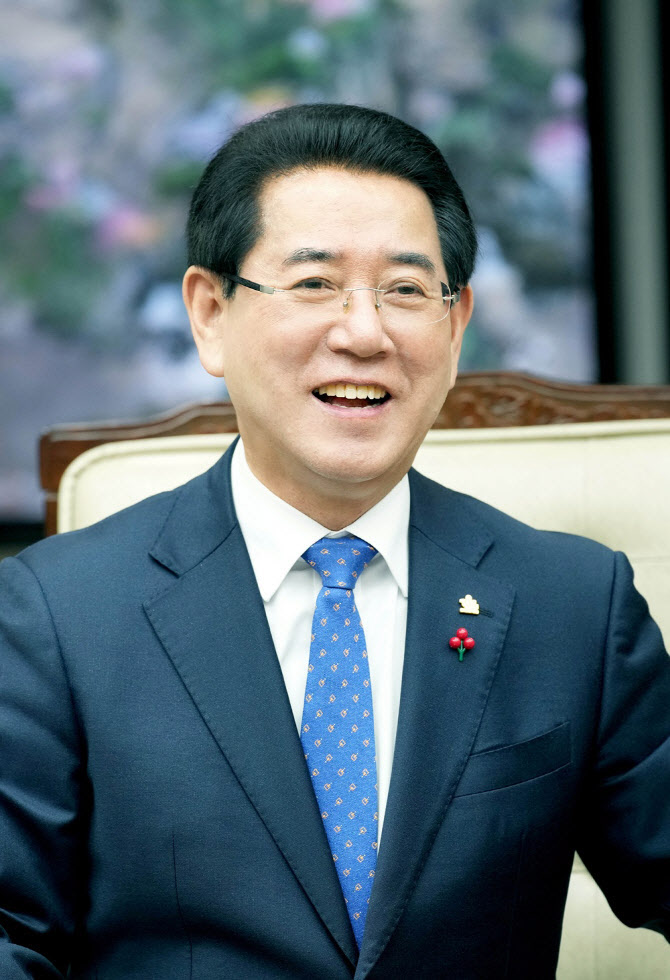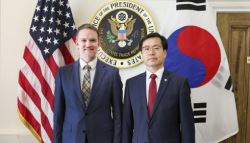In an interview with Edaily, Young-rok Kim, Governor of Jeollanam-do, proposed a ‘local-led balanced development’ strategy as a solution to the population crisis and overcoming regional extinction. The concept is that regions should build self-sufficiency, while the central government provides balanced support. Governor Kim is scheduled to present Jeollanam-do’s key policy initiatives at the “Edaily-Policy Evaluation Research Institute (PERI) Special Symposium” to be held at the Shilla Hotel in Seoul on the 19th, under the theme of “Regional Policies in the Era of Low Birth Rates.”
|
Governor Kim diagnosed that to overcome the severe population crisis facing Jeollanam-do, the region must build its own competitiveness. For this, local-led balanced development is necessary. He stated, “The core of regional policy in the era of low birthrates is not simply increasing the population, but rather restoring self-sufficiency by creating a sustainable living environment for the region itself.” He analyzed, “Jeollanam-do views population decline not just as a numerical issue, but as a structural crisis where the foundations of life, such as school closures, fewer hospitals, the collapse of local commercial districts, and the dissolution of rural and fishing communities, are disappearing.”
Jeollanam-do is the region experiencing the most severe population decline in Korea. The population, which reached 2.5 million in the 1990s, has steadily decreased to around 1.78 million today. This means a reduction of 700,000 over 34 years, equivalent to the combined population of Yeosu, Suncheon, and Gwangyang.
eosu, Suncheon, and Gwangyang.
The main causes of population decline are rapid aging and the outflow of young people. Jeollanam-do sees approximately 20,000 deaths annually, and due to the concentration of population in the Seoul metropolitan area, about 8,000 young people leave the region each year. Statistics Korea predicts that if this trend continues, the population of Jeollanam-do will fall to the 1.6 million range by 2030 and the 1.5 million range by 2043. The proportion of elderly is expected to surge from 22.9% in 2020 to 49.5% by 2050.
Recognizing this as a collapse of the community foundation, Jeollanam-do declared 2024 as the ‘First Year of Overcoming the Local Extinction Crisis’ and launched comprehensive countermeasures. The most representative is the ‘Population Transformation Project,’ which will invest a total of 1.3187 trillion KRW by 2030 under five major strategies: family, opportunity, inflow, settlement, and coexistence. The core aim is to support the entire life cycle, including childbirth allowances, youth start-up support, and senior-friendly infrastructure, and encourage long-term settlement.
Jeollanam-do is also working hard to build a sustainable youth-centered startup ecosystem. For those returning to rural areas, the province offers step-by-step customized support from short-term experiences to housing, job matching, and community adaptation. Specifically, it is promoting the ‘3·3·3 Project’ to foster 3,000 venture start-ups, 300 scale-ups, and 30 value-up companies by 2034, as well as the ‘Jeonnam-style 10,000-KRW Housing’ program,’ where newlyweds and young people can live in rental apartments for as little as 10,000 KRW per month for up to 10 years. It has also introduced public postpartum care centers and is expanding the ‘Jeonnam-type 24-hour Childcare Center’ for night care.
Governor Kim emphasized, “To help young people and returnees to settle stably in the region, we need policies that build the foundations for everyday life, not one-off support. Creating a region where young people and returnees want to stay is the surest way to overcome the population crisis and regional extinction.”
These efforts are leading to real change. As of the first quarter of this year, Jeollanam-do’s total fertility rate reached 1.13, the highest in the nation and 0.31 higher than the national average. The cumulative number of births in the first quarter also increased by 6.5% year-on-year to 2,231. Governor Kim said, “For policies to yield results, local governments must have real authority as the main actors in problem-solving. We need to strengthen local autonomy and financial authority so that policies tailored to regional characteristics can be designed and implemented, while the central government flexibly supports this.”
◇“Financial Innovation for Local Self-reliance Cannot Be Delayed”
Governor Kim also stressed that financial independence is essential for local survival. He explained, “The average fiscal self-reliance rate of local governments in Korea is 43.2%, making it difficult to secure true autonomy, responsibility, and competitiveness for local decentralization. In particular, Jeollanam-do faces structural limitations in securing tax revenue due to aging and a weak industrial base, so its fiscal independence rate remains at 23.7%.” As a result, central government support is absolutely essential. For example, Jeollanam-do has faced difficulties in implementing projects since last year when central government support for returning to farming and fishing villages from the Ministry of Agriculture, Food and Rural Affairs was completely cut.
To increase fiscal self-reliance, Governor Kim proposed several measures: △Expanding the local tax share from the current 25% to 40%, △Fostering regionally specialized industries, △Strengthening local tax bases by identifying new sources of revenue from the influx of young people, △Institutional improvements to expand local finances.
He also introduced efforts to reduce the gap with the Seoul metropolitan area and build a regional-centered economic and industrial structure: △Fostering locally tailored high-tech industries, △Expanding renewable energy through offshore wind power clusters and agricultural solar power complexes to realize energy-based basic income, △Creating an AI energy new town, ‘Solasido’, △Relocating secondary public institutions to the provinces, △Forming a mega-city alliance in the Honam region.
Governor Kim said, “With population, industry, and capital excessively concentrated in the Seoul metropolitan area, the provinces are experiencing intensified aging due to the outflow of young people, which ultimately leads to regional extinction. To resolve this, a multifaceted approach combining finance, industry, and infrastructure is essential.”
About Young-rok Kim, Governor of Jeollanam-do
△ Graduated from Gwangju Jeil High School, △ Bachelor’s in Public Administration, Konkuk University, △ Master’s, Maxwell School of Citizenship and Public Affairs, Syracuse University, △ 21st National Administrative Examination, △ Former Mayor of Gangjin County, △ Former Mayor of Wando County, △ Former Public Relations Director, Ministry of Government Administration and Home Affairs, △ Former Vice Governor of Jeollanam-do, △ 18th Member of the National Assembly,△ Former Minister of Agriculture, Food and Rural Affairs, △ 38th and 39th Governor of Jeollanam-do










